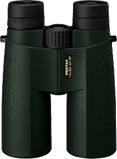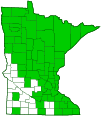Paper birch
(Betula papyrifera)
Conservation • Wetland • Description • Habitat • Ecology • Use • Distribution • Taxonomy
Conservation Status |
|||
| IUCN Red List | not listed |
||
| NatureServe | N5 - Secure SNR - Unranked |
||
| Minnesota | not listed |
||
Wetland Indicator Status |
|||
| Great Plains | FACU - Facultative upland |
||
| Midwest | FACU - Facultative upland |
||
| Northcentral & Northeast | FACU - Facultative upland |
||
Description
Paper birch is a medium-sized, fast-growing, deciduous tree. It rises often on a single trunk, sometimes 2 or more trunks, from a shallow root system. It can reach up to 98′ tall and 32″ or more in diameter at breast height, though in Minnesota mature trees are usually no more than 60′ tall and 24″ in diameter. It is short-lived, usually surviving no more than 120 years, though older individuals can be up to 250 years old.
The trunk is slender, often curved, and often slightly leaning. It is distinct into the middle part of the crown or higher with few lower branches. The crown is pyramidal on young trees, narrowly oval and open on mature trees. The branches are ascending.
The bark on trees less than 5 years old is thin, smooth, and reddish-brown or orangish-brown, with conspicuous, pale, horizontal lenticels. On mature stems the bark is bright, creamy white with prominent, dark lenticels. The white bark is thin and peels in papery, horizontal strips. It often sheds in large sheets. The inner bark is reddish-orange. At the base of older trees the bark often becomes gray and deeply furrowed.
First-year twigs are slender and hairy at first, becoming dark reddish-brown with sparse, warty lenticels. Second-year twigs are hairless. Freshly cut twigs do not have a wintergreen odor or taste.
The buds are slender, 3 ⁄16″ to ¼″ long, tapered, and hairless. They are widest at the base and taper to a blunt point. The are covered with chestnut-brown scales that are often greenish at the base. They are covered with resin, making them gummy to the touch.
The leaves are deciduous and alternate. They are borne on shoots; 2 or sometimes 3 from a short, lateral shoot, and 1 from a longer shoot at the end of the twig. Each leaf is on a ⅜″ to 1″ long, usually hairless leaf stalk (petiole). The petiole is not flattened. The leaf blade is egg-shaped, 2″ to 4″ long, and 1¼″ to 2½″ wide. It is rounded, broadly angled, or nearly straight across at the base. It tapers to a point at the tip with straight or concave sides along the tip. The upper surface is dark green, dull, and hairless or nearly hairless. The lower surface is pale green and hairy along the main vein and in the vein axils. The margins are doubly-toothed with sharp, forward pointing teeth. There are 35 to 55 teeth per side. In autumn the leaves turn light yellow.
Male and female flowers are borne on the same tree and on the same branch. Male catkins are preformed in the late summer. They droop singly or in groups of 2 or 3 from the tips of leafless twigs, and sometimes from lateral shoots. They are ¾″ to 1″ long the first year, growing to 1½″ to 4″ long the following spring.
Female catkins appear singly on leafy, lateral branchlets on current-year twigs. They are ⅜″ to ¾″ long and erect.
The fruit is a cylinder-shaped cone containing many tiny, two-winged nutlets (samaras). It ripens in mid-August to mid-September. The nutlets are dispersed in the fall and early winter.
Height
40′ to 65′
Record
The champion paper birch in Minnesota is on private property near Hibbing, in St. Louis County. In 2023 it was measured at 55′ tall and 146″ in circumference (46½″ in diameter), with a crown spread of 62½′.
Flower Color
Green
Similar Species
Mountain paper birch (Betula cordifolia) leaf blade has a heart-shaped base.
Habitat
Moist to dry. Shade intolerant.
Ecology
Flowering
Late April to early June
Pests and Diseases
Birch-leaf blotchminer moth (Cameraria betulivora)
In 1988-89 Minnesota lost as much as 20% of its paper birch trees due to drought.
Use
Betula papyrifera is the state tree of New Hampshire.
Distribution |
||
|
Sources 2, 3, 5, 7, 8, 24, 28, 29, 30. Biodiversity occurrence data published by: Minnesota Biodiversity Atlas (accessed through the Minnesota Biodiversity Atlas Portal, bellatlas.umn.edu, 11/4/2025). |
|
| 11/4/2025 | ||
Nativity |
||
Native |
||
Occurrence |
||
Very common |
||
Taxonomy
Kingdom
Division
Tracheophyta (Vascular Plants)
Subdivision
Spermatophytina (Seed Plants)
Class
Order
Fagales (Beeches, Oaks, Walnuts, and Allies)
Family
Betulaceae (Birch)
Subfamily
Betuloideae
Genus
Betula
Subgenus
Betula (typical birches)
Section
Betula
Subordinate Taxa
A few subspecies and many varieties have been described. Betula papyrifera var. commutata has more or less close, dark brown bark. It occurs locally throughout the range of Betula papyrifera. According to Flora of North America (FNA), the characteristic is now believed to be environmentally caused. Most sources, including ITIS, GBIF, GRIN, FNA, NatureServe, Plants of the World Online, and World Flora Online, do not recognize any subspecies or varieties.
Synonyms
Betula alba ssp. excelsa
Betula alba ssp. latifolia
Betula alba ssp. papyrifera
Betula alba var. communis
Betula alba var. commutata
Betula alba var. elobata
Betula alba var. papyrifera
Betula dahurica var. americana
Betula davurica var. americana
Betula excelsa
Betula grandis
Betula kamtschatica var. kenaica
Betula kenaica
Betula latifolia
Betula lenta var. papyrifera
Betula lyalliana
Betula montanensis
Betula neoalaskana var. kenaica
Betula papyracea
Betula papyracea var. communis
Betula papyracea var. grandis
Betula papyracea var. lyalliana
Betula papyrifera ssp. commutata
Betula papyrifera ssp. kenaica
Betula papyrifera ssp. papyrifera
Betula papyrifera ssp. subcordata
Betula papyrifera var. andrewsii
Betula papyrifera var. communis
Betula papyrifera var. commutata
Betula papyrifera var. elobata
Betula papyrifera var. kenaica
Betula papyrifera var. lyalliana
Betula papyrifera var. macrostachya
Betula papyrifera var. montanensis
Betula papyrifera var. papyrifera
Betula papyrifera var. pensilis
Betula papyrifera var. recessa
Betula papyrifera var. subcordata
Betula pirifolia
Betula subcordata
Common Names
canoe birch
eastern paper birch
paper birch
silver birch
western paper birch
white birch
Glossary
Axil
The upper angle where a branch, stem, leaf stalk, or vein diverges.
Catkin
A slim, cylindrical, drooping cluster of many flowers. The flowers have no petals and are either male or female but not both.
Lenticel
A corky, round or stripe-like, usually raised, pore-like opening in bark that allows for gas exchange.
Petiole
On plants: The stalk of a leaf blade or a compound leaf that attaches it to the stem. On ants and wasps: The constricted first one or two segments of the rear part of the body.
Samara
A dry fruit consisting of a seed attached to a papery wing; one seeded in Elms and Ashes, two-seeded in Maples.
Visitor Photos
Share your photo of this plant.
This button not working for you?
Simply email us at info@MinnesotaSeasons.com.
Attach one or more photos and, if you like, a caption.
Luciearl |
||
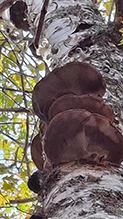 |
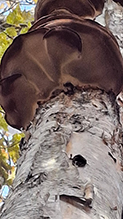 |
|
Fungi on birch |
Fungi on birch |
|
 |
 |
|
Fungi on birch |
|
|
Dan W. Andree |
 |
Paper Birch... They are naturally beautiful. |
MinnesotaSeasons.com Photos
 |
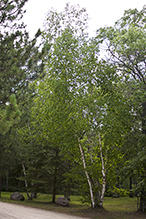 |
|
Plant |
||
|
||
|
||
|
Plant |
|
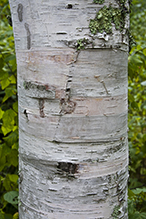 |
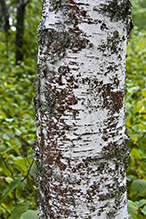 |
|
Bark |
Bark |
|
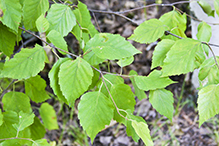 |
||
Leaves |
|
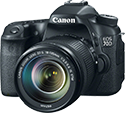
Slideshows
Betula papyrifera
Blake C. Willson
Paper Birch Tree Video
valski716
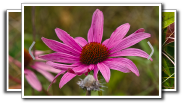
Visitor Videos
Share your video of this plant.
This button not working for you?
Simply email us at info@MinnesotaSeasons.com.
Attach a video, a YouTube link, or a cloud storage link.
Other Videos
Trees with Don Leopold - paper birch
ESFTV
how to identify Betula papyrifera
Laura Deeter
Fire with Wet Birch Bark and Firesteel
survivethewild

Visitor Sightings
Report a sighting of this Plant.
This button not working for you?
Simply email us at info@MinnesotaSeasons.com.
Be sure to include a location.
MinnesotaSeasons.com Sightings
Avon Hills Forest SNA, North Unit
Badoura Jack Pine Woodland SNA
Beaver Creek Valley State Park
Carpenter St. Croix Valley Nature Center
Charles A. Lindbergh State Park
George Crosby Manitou State Park
Itasca Wilderness Sanctuary SNA
John Peter Hoffman Spring Brook Valley WMA
Lake Alexander Woods SNA, South Unit
Robert Ney Memorial Park Reserve
Spring Beauty Northern Hardwoods SNA
